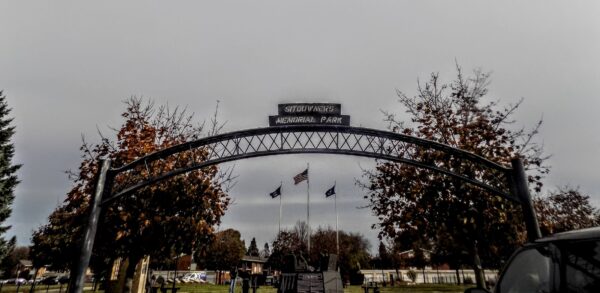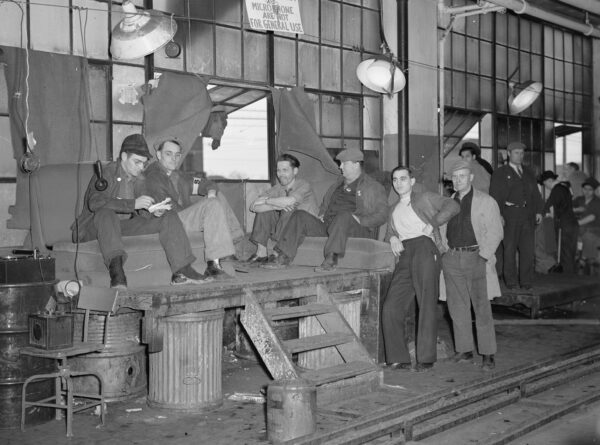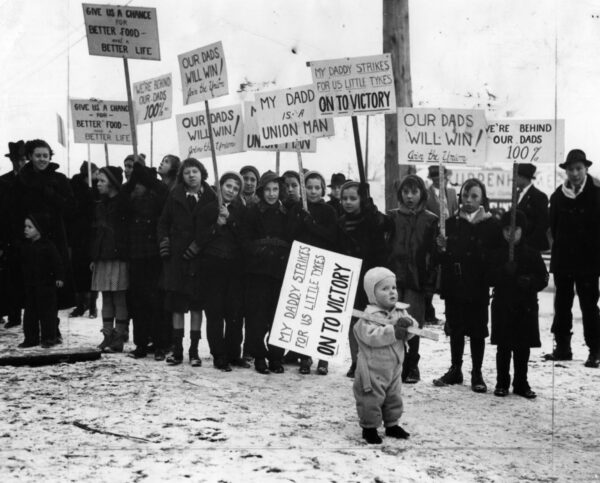Forty-four days before I left for Michigan, the United Auto Workers began a labor action that their first directly elected president, Shawn Fain called a “Stand Up Strike.” I have to believe that he chose this term to deliberately evoke the 1937 UAW sit-down strike at General Motors. This somewhat unprecedented and historic labor action not only secured major wage, safety, and job security concessions but it forced GM to recognize the union as the collective bargaining agent for its workers. (Fain might have also been winking at the NLRB ruling supported by the 1939 Supreme Court decision that declared sit-down strikes illegal.) The 1937 strike lasted precisely 44 days and all but made imperative a visit to the Sit-Down Men Stand Up Women Monument in Flint. (The 2023 strike settled on its 46th day.)
Quanto mais eles os mesmos.
Yes, this section header translates as, “the more they stay the same” thus completing the aphorism from the previous entry. Let’s see why.
Bath Township is about seven miles north of East Lansing, the place I planned to end my day. Flint is nearly 50 miles east meaning I drove nearly 100 miles round trip to visit this small memorial park behind the UAW headquarters

in this rather beaten and battered city so there must be a good reason. There’s more than one, in fact, starting with it honoring labor’s success in the first major dispute in the U.S. auto industry.
Let’s start with a look at some of the labor conditions that led to the strike. According to government statistics, the average family of four required an annual income of $1,600 to maintain an adequate standard of living in 1935. The average auto worker earned $900. (There was no minimum wage until 1938.)
In a 2012 interview with the Gaylord Herald Times, Earl Henry, then chairman of the committee for UAW retirees in Gaylord, recalled, “Production could never slow down. You were allowed a half hour for lunch, if they let you take it. There were no breaks in an eight- or 10-hour day and half a day on Saturday. If you wanted to get a drink of water or go to the bathroom, there were no relief people to cover for you. A lot of the workers would soil or wet themselves.” (Think of some post-pandemic complaints by Amazon warehouse workers – mais eles os mesmos,)
This was due, in large part to the plant operating on what was effectively a piecework system that frequently left the workers exhausted and ill. Here’s how Henry described it, “There was no overtime pay, sick pay, vacation pay or workman’s comp, Henry said. “If machines broke down the workers sat for hours without pay until it was fixed. The plants would close for two or three months every year to change models and workers would be laid off. There was no unemployment or any other type of benefits.”

(From bentley.umich.edu via Pinterest).
Contemporary sources report descriptions supporting Henry’s 2012 comments.
Henry added that before the strike, “There were no safety requirements, no medical help on-site. Lots of workers lost fingers and hands and some were killed. There was no compensation for the injuries or for the family if they got killed. Workers would fall and break a leg and sometimes the bosses would set them aside and make them wait before they loaded them up to get help.”
Additionally, July 1936 had been unusually hot in Michigan. Many people believe this heat wave so exacerbated the working conditions described above that it led to hundreds of deaths in Michigan auto plants in that month alone.
Why sit-down.
The seed for a large-scale sit-down strike might have been planted on 12 November 1936 when three welders participated in a “quickie sit-down” strike at Fisher Body No. 1. When they were fired the next morning, 700 hundred men sat down in protest and the three were rehired later the same day. This success generated a boom in union membership with a tenfold increase from 150 to 1,500 in Flint alone.
On 28 December, UAW members launched a small scale strike protesting the firing of two brothers at a Fisher Body plant in Cleveland. The UAW then announced that they wouldn’t settle the Cleveland strike until they reached a national contract. On 30 December 1936, when the union learned of GM’s intent to move certain elements of production out of Fisher No. 1, they accelerated their strike plans and took control of of that plant that day. Two days later they took control of Fisher No. 2.

(From Library of Congress – Jeremy Becher).
GM began applying pressure to local politicians – whom they effectively controlled – while also tapping many darker forces in their efforts to first prevent and subsequently break the strike. Among those were the Pinkerton Detective Agency and a secret society called the Black Legion – a group writer Tom Stanton describes as “a more violent version of the Ku Klux Klan.
Remaining inside the plants provided strikers with protection from both violence (that would be forthcoming) and weather. Additionally, because they were occupying the plant, they couldn’t be replaced by scabs or other workers unwilling to go along with the strike. On 11 January 1937, in what strikers called mockingly “The Battle of Bulls Run”, the police, armed and carrying teargas assaulted Fisher No. 2. The workers repelled them by pelting them with spare parts and bottles. (Bull was a common slang term for police in the 1930s and Bull Run was the site of two noteworthy battles in the American Civil War.)

(By Sheldon Dick – Public Domain).
A critical moment came when the strike expanded to Chevy Plant Number Four – the largest plant owned by GM – on 1 February 1937. However, the union needed to employ some misdirection to pull this off and critical to their success in both this and in maintaining the strike were the efforts of the
Emergency Brigade.
The beginning of the Great Depression of the 1930s saw a change in the makeup of workers on automotive factory floors. When they could, the automakers would layoff male workers and replace them with women who they generally paid 50 percent less than the men they replaced. Their working conditions were no better than they had been for the men.

(From rankandfile.ca).
In 1979 documentary With Babies And Banners, Nelly Besson, who would become a lieutenant in the Emergency Brigade said, “There was no safety equipment of any kind. One day a girl lost two fingers and when I went in for my shift, there was a finger still laying on the press.”
When the strike began on 30 December, no women participated. This was due in part to the social mores of the period that were intensified by letters that GM sent to the wives of married workers impugning the morality of the women working in the shop.
It’s likely that the first level of support for the strike came from the Women’s Auxiliary. These women ran the kitchens that provided food to the Sit-Downers, printed and distributed signs, staffed first-aid stations, and provided childcare for mothers who were otherwise engaged in supporting the strike. Some also walked picket lines outside the plants. Some mothers brought their children to the picket lines.

(from mlive.com).
Although the Emergency Brigade wasn’t officially formed until 20 January, some reports say that they played a critical role in ending the Battle of Bulls Run. According to Besson’s recollection, “The cops were shooting into the bellies of unarmed men and the mothers of children… I begged the women to break through those lines of cops and come down here and join with us.
“After that, other women came. The police didn’t want to shoot them in the back. The women poured through and that ended the battle.” Though no deaths were reported, the “battle” injured 28 officers and strikers.
Defying the orders of a local judge who had granted GM an injunction (but who, it was later revealed, also owned 200,000 shares of GM stock), the Sit-Downers moved to strike at GM’s heart, Chevrolet plant No. 4 which made most of their engines. To divert the local police, members of the newly established Emergency Brigade formed a human chain across the gates of Plant No. 9 facing down teargas and other threats while providing other strikers time to enter and sit-down at No. 4.
The strike lasted another 10 days but on 11 February 1937, GM agreed to a contract that granted a $25,000,000 wage increase (equivalent to more than half a billion dollars in 2023), but more importantly, recognized the union. Workers who had been standing at the back of the line when it came to getting ahead by standing (or sitting) on the front line faced down the might of General Motors. It’s this struggle and the contributions of the men and women who beat the odds that this park memorializes.
